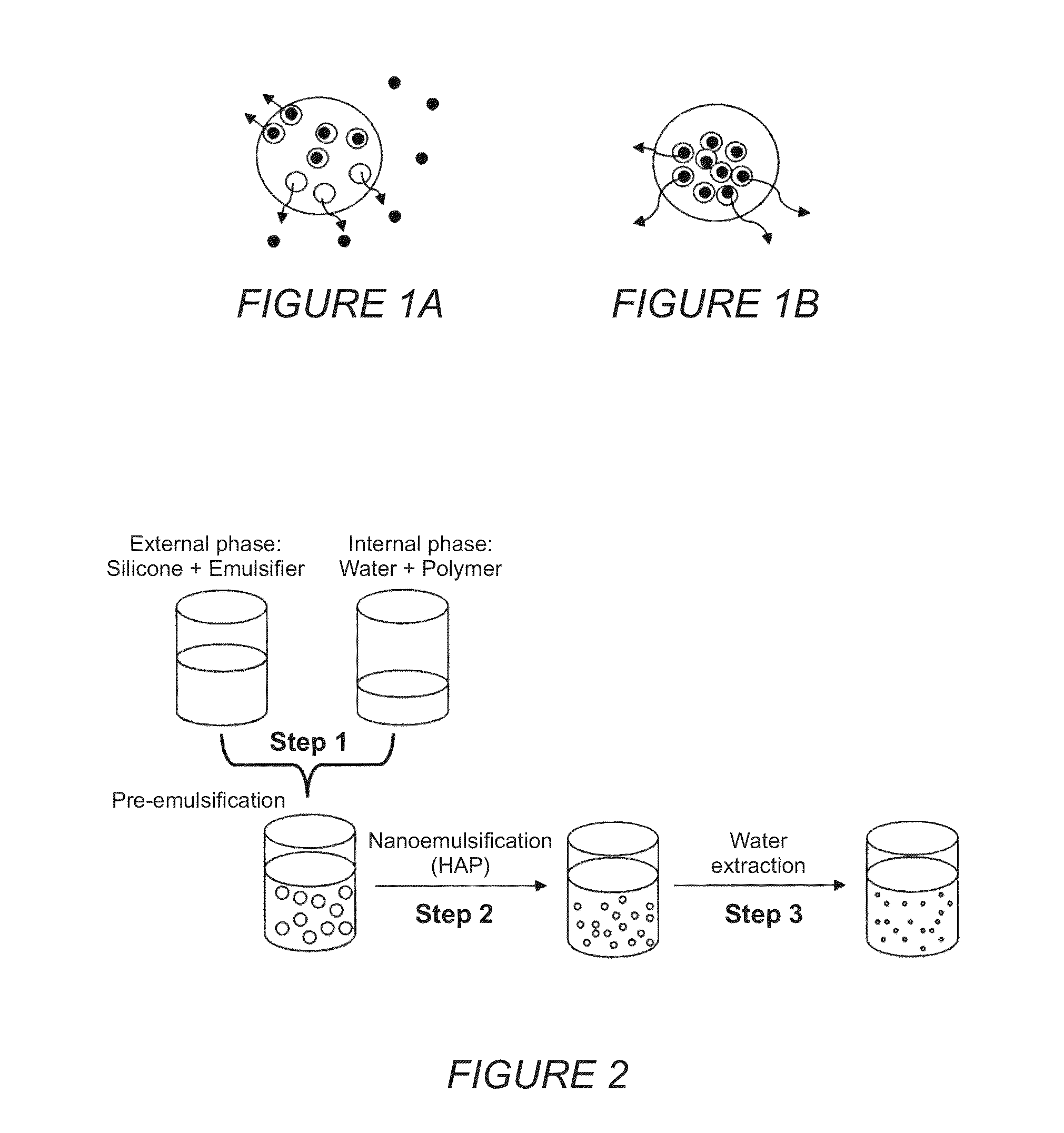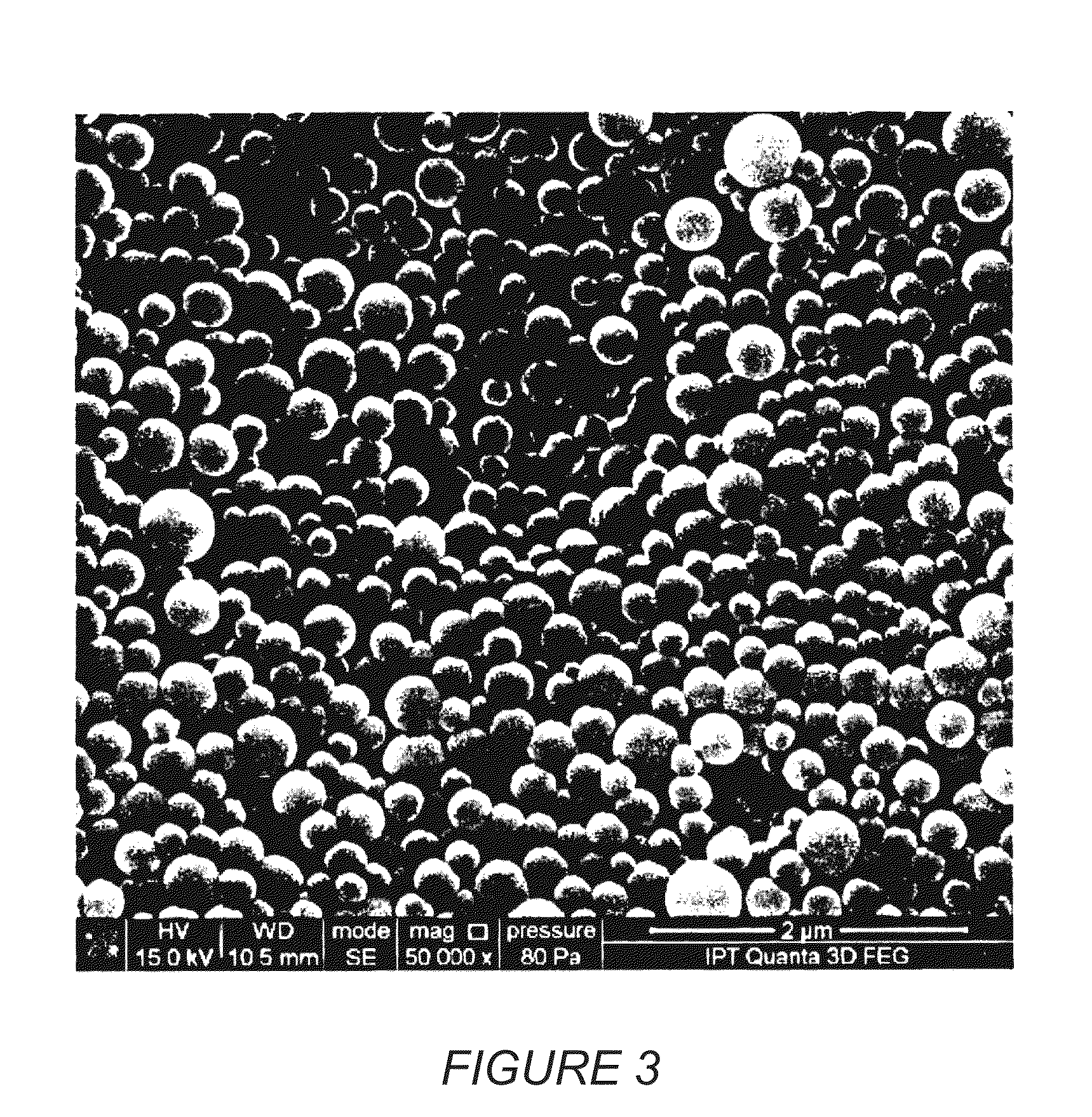Colloidal nanoscale carriers for active hydrophilic substances and method for producing same
a technology of active hydrophilic substances and nano-scale carriers, which is applied in the direction of emulsion delivery, biocide, animal husbandry, etc., can solve the problems of system failure, complexity concerning specificity, and the likelihood of reducing the ability to reach the target, and achieves the stability of formulation, modulation of colloidal stability, and high encapsulation efficiency
- Summary
- Abstract
- Description
- Claims
- Application Information
AI Technical Summary
Benefits of technology
Problems solved by technology
Method used
Image
Examples
example 1
Obtaining CN Starch-Based in Silicone
[0065]In a 500 mL beaker was prepared a solution containing 140 g of an emulsifier-based silicone-modified polioxydethylene (SF1540, Momentive®) in the concentration dimethicone 3% m / m. Another solution was prepared by dissolution of 9 g of starch and 0.6 g NaCl in 51 g of deionized water. The aqueous starch solution was emulsified in the hydrophilic phase not under mechanical agitation of 1000 rpm. After this emulsification, the mixture was subjected to high pressure homogenization for five cycles at a pressure of 900 bar. Finally, the emulsion was brought to a jacketed glass reactor to effect the removal of water by distillation under vacuum, at pressure of 280 mmHg. The water removal was conducted for 3 hours and 5 hours in dehumidifying 50° C. The NCs were characterized as the average particle diameter (DP), polydispersity index (PI), residual water content (TA), viscosity (Visc), turbidimetry and dynamic morphology. The results are shown in ...
example 2
Obtaining NC-Based Polyvinylpyrrolidone (PVP) in Silicone
[0068]In a 500 mL beaker was prepared 140 g of a solution containing an emulsifier to the silicone-modified polioxydethylene (SF1540, Momentive®) in the concentration dimethicone 3% by mass. Another solution was prepared by dissolution of 9 g of PVP and 0.6 g NaCl in 51 g of deionized water. The water solution of PVP was emulsified in the hydrophilic phase not under mechanical agitation of 1000 rpm. After this emulsification, the mixture was subjected to high pressure homogenization with five cycles at 900 bar pressure. Finally, the emulsion was brought to a jacketed glass reactor to effect the removal of water by distillation under vacuum (280 mmHg). The water removal was conducted for 3 hours and 5 hours in case of temperature of 50° C. The NCs obtained in this example were characterized as the average particle diameter (DP), polydispersity index (IP), residual water content (TA), viscosity (Visc), refractive index (IR), tur...
example 3
Obtaining CN Chitosan-Based in Silicone
[0070]Obtaining the CN based on chitosan was performed in a 500 mL beaker was prepared where 140 g of a solution containing an emulsifier to the silicone-modified polioxydethylene (SF1540, Momentive®) in the concentration dimethicone 3% m / m. Another solution was prepared by solubilizing 1.2 g chitosan and 0.6 g NaCl in 51 g of deionized water. The aqueous chitosan solution was emulsified in the hydrophilic phase not under mechanical agitation of 1000 rpm. After this emulsification, the mixture was subjected to high pressure homogenization with five cycles at 900 bar pressure. Finally, the emulsion was brought to a jacketed glass reactor to effect the removal of water by distillation under vacuum of 280 mmHg. The removal of water was carried out for 3 to 5 hours at 50° C. NCs obtained in this example were characterized as the average particle diameter (DP), polydispersity index (PI), residual water content (TA), viscosity (Target), turbidimetry ...
PUM
| Property | Measurement | Unit |
|---|---|---|
| Temperature | aaaaa | aaaaa |
| Temperature | aaaaa | aaaaa |
| Temperature | aaaaa | aaaaa |
Abstract
Description
Claims
Application Information
 Login to View More
Login to View More - R&D
- Intellectual Property
- Life Sciences
- Materials
- Tech Scout
- Unparalleled Data Quality
- Higher Quality Content
- 60% Fewer Hallucinations
Browse by: Latest US Patents, China's latest patents, Technical Efficacy Thesaurus, Application Domain, Technology Topic, Popular Technical Reports.
© 2025 PatSnap. All rights reserved.Legal|Privacy policy|Modern Slavery Act Transparency Statement|Sitemap|About US| Contact US: help@patsnap.com



